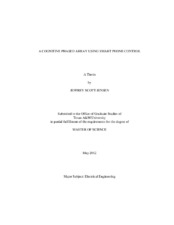| dc.contributor.advisor | Huff, Gregory H. | |
| dc.creator | Jensen, Jeffrey | |
| dc.date.accessioned | 2012-07-16T15:57:54Z | |
| dc.date.accessioned | 2012-07-16T20:23:30Z | |
| dc.date.available | 2014-09-16T07:28:19Z | |
| dc.date.created | 2012-05 | |
| dc.date.issued | 2012-07-16 | |
| dc.date.submitted | May 2012 | |
| dc.identifier.uri | https://hdl.handle.net/1969.1/ETD-TAMU-2012-05-10856 | |
| dc.description.abstract | Cognitive radio networks require the use of computational resources to reconfigure transmit/receive parameters to improve communication quality of service or efficiency. Recent emergence of smart phones has made these resources more accessible and mobile, combining sensors, geolocation, memory and processing power into a single device. Thus, this work examines an integration of a smart phone into a complex radio network that controls the beam direction of a phased array using a conventional method, but utilizes the phone's internal sensors as an enhancement to generate beam direction information, Bluetooth channel to relay information to control circuitry, and Global Position System (GPS) to track an object in motion.
The research and experiments clearly demonstrate smart phone's ability to utilize internal sensors to generate information used to control beam direction from a phased array. Computational algorithms in a network of microcontrollers map this information into a DC bias voltage which is applied to individual phase shifters connected to individual array elements.
To test algorithms and control theory, a 4 by 4 microstrip patch array is designed and fabricated to operate at a frequency of 2.4 GHz. Simulations and tests of the array provide successful antenna design results with satisfactory design parameters. Smart phone control circuitry is designed and tested with the array. Anechoic test results yield successful beam steering capability scanning 90 degrees at 15 degree intervals with 98% accuracy in all cases. In addition, the system achieves successful beam steering operable over a bandwidth of 100 MHz around resonance. Furthermore, these results demonstarate the capability of the smart phone controlled system to be used in testing further array formations to achieve beam steering in 3-Dimensional space. It is further noted that the system extends capabilities of integrating other control methods which use the smart phone to process information. | en |
| dc.format.mimetype | application/pdf | |
| dc.language.iso | en_US | |
| dc.subject | Phased Arrays | en |
| dc.subject | Phased Array Control | en |
| dc.subject | Smartphone | en |
| dc.title | A Cognitive Phased Array Using Smart Phone Control | en |
| dc.type | Thesis | en |
| thesis.degree.department | Electrical and Computer Engineering | en |
| thesis.degree.discipline | Electrical Engineering | en |
| thesis.degree.grantor | Texas A&M University | en |
| thesis.degree.name | Master of Science | en |
| thesis.degree.level | Masters | en |
| dc.contributor.committeeMember | Chamberland, Jean-Francois | |
| dc.contributor.committeeMember | Pfister, Henry | |
| dc.contributor.committeeMember | Hogan, Harry | |
| dc.type.genre | thesis | en |
| dc.type.material | text | en |
| local.embargo.terms | 2014-07-16 | |


